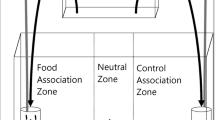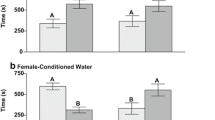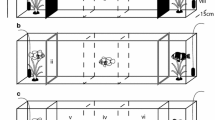Abstract
Few studies have addressed how chemosensation may be impaired by chemical alterations of the environment and anthropogenic disturbance. Humic acid (HA) is a pervasive, naturally occurring organic derivative found in aquatic and terrestrial environments; human activity, however, can lead to elevated levels of HA. Recent studies suggest that environments that contain high levels of HA may hinder chemical communication. We tested the ability of adult zebrafish (Danio rerio) to discriminate between conspecific and heterospecific urinary chemical cues found in the presence and absence of HA. We show that high humic acid levels (200 mg/l) can impair the ability to differentiate conspecifics from heterospecifics. We also found that zebrafish prefer untreated water over HA-treated water. These findings suggest that, in addition to human-produced synthetic compounds, changes in the abundance of naturally occurring substances may also negatively impact natural behaviors in aquatic species by disturbing the sensory environment.



Similar content being viewed by others
References
Atema, J., Kingsford, J. M., and Gerlach, G. 2002. Larval reef fish could use odour for detection, retention and orientation to reefs. Mar. Ecol. Prog. Ser. 241:151–160.
Atiyeh, R. M., Lee, S., Edwards, C. A., Arancon, N. Q., and Metzger, J. D. 2002. The influence of humic acids derived from earthworm-processed organic wastes on plant growth. Bioresour. Technol. 84:7–14.
Delaney, M., Follet, C., Ryan, N., Hanney, N., Lusk-yablick, J., and Gerlach, G. 2002. Social interaction and distribution of female zebrafish (Danio rerio) in a large aquarium. Biol. Bull. 203:240–241.
Engeszer, R. E., Ryan, M. J., and Parichy, D. M. 2004. Learned social preference in zebrafish. Curr. Biol. 14:881–884.
Fisher, H. S., Wong, B. B. M., and Rosenthal, G. G. 2006. Alteration of the chemical environment disrupts communication in a freshwater fish. Proc. R. Soc. Lond. Biol. Sci. 273:1187–1193.
Food and Agriculture Organization. 2002. FAOSTAT, Rome. http://www.apps.fao.org.
Gerlach, G. 2006. Pheromonal regulation of reproductive success in female zebrafish: female suppression and male enhancement. Anim. Behav. 72:1119–1124.
Gerlach, G., and Lysiak, N. 2006. Kin recognition and inbreeding avoidance in zebrafish is based on phenotype matching. Anim. Behav. 71:1371–1377.
Gerlach, G., Atema, J., Kingsford, M. K., Black, K. P., and Miller-sims, V. 2007. Smelling home can prevent dispersal of reef fish larvae. Proc. Natl. Acad. Sci. U.S.A. 104:858–863.
Geckler, J. R., Horning, W. B., Neiheisel, T. M., Pickering, Q. H., Robinson, E. L., and Stephen, C. E. 1976. Validity of laboratory tests for predicting copper toxicity in streams. Ecological Research Series, USEPA-600/3-76-116, U.S. Environmental Protection Agency, Duluth no. 192.
Hubbard, P. C., Barata, E. N., and Canario, A. V. 2002. Possible disruption of pheromonal communication by humic acid in the goldfish, Carassius auratus. Bioresour. Technol. 60:169–183.
Kappler, A., and Haderlein, S. B. 2003. Natural organic matter as reductant for chlorinated aliphatic pollutants. Environ. Sci. Technol. 37:2714–2719.
Li, C. 1995. Impact of agricultural practices on soil C storage and N2O emissions in 6 states in the US, pp. 101–112, in R. Lai, J. Kimball, E. Levine, B.A. Stewart, and R. Lai, et al (eds.). Soil Management and Greenhouse Effect. CRC, Boca Raton, FL, USA.
Malcolm, R. L., and Mccarthy, P. 1986. Limitations in the use of commercial humic acids in water and soil research. Environ. Sci. Technol. 20:904–911.
Mann, K. D., Turnell, E. R., Atema, J., and Gerlach, G. 2003. Kin recognition in juvenile zebrafish (Danio rerio) based on olfactory cues. Biol. Bull. 205:224–225.
Mcclure, M. M., Mcintyre, P. B., and Mccune, A. R. 2006. Notes on the natural diet and habitat of eight danionin fishes, including the zebrafish Danio rerio. J. Fish Biol. 69:553–570.
Mesquita, R., Canário, A. V. M., and Melo, E. 2003. Partition of fish pheromones between water and aggregates of humic acids. Consequences for sexual signaling. Environ. Sci. Technol. 37:742–746.
Moore, P. A., and Grills, J. L. 1999. Chemical orientation to food by the crayfish Orconectes rusticus: influence of hydrodynamics. Anim. Behav. 58:953–963.
Robertson, G. P., Paul, E. A., and Harwood, R. R. 2000. Greenhouse gases in intensive agriculture: contributions of individual gases to the radiative forcing of the atmosphere. Science 289:1922–1925.
Rosenthal, G. G., and Lobel, P. 2006. Communication, pp. 39–78, in K. Sloman, S. Balshine, and R. Wilson (eds.). Behaviour and Physiology of Fish, vol. 24. Academic, New York.
Rosenthal, G. G., and Ryan, M. J. 2005. Assortative preferences for stripe patterns in danios. Anim. Behav. 70:1063–1066.
Russell, S. T., Kelley, J. L., Graves, J. A., and Magurran, A. E. 2004. Kin structure and shoal composition dynamics in the guppy. Poecilia reticulate. Oikos 106:520–526.
Seehhausen, O., Van Alphen, J. J. M., and Witte, F. 1997. Cichlid fish diversity threatened by eutrophication that curbs sexual selection. Science 277:1808–1811.
Slabbekoorn, H., and Peet, M. 2003. Birds sing at a higher pitch in urban noise. Nature 464:267.
Spence, R., Fatema, M. K., Reichard, M., Huq, K. A., Wahab, M. A., Ahmed, Z. F., and Smith, C. R. 2006. The distribution and habitat preferences of the zebrafish in Bangladesh. J. Fish Biol. 69:1–14.
Sprague, J. B. 1962. Effects of sublethal zinc and copper on migration of Atlanic salmonUS Public Health Service Publication, Washington, DC (no. 999-WP-25).
Stacey, N., Chojnacki, A., Narayanan, A., Cole, T., and Murphy, C. 2003. Hormonally derived sex pheromones in fish: exogenous cues and signals from gonad to brain. Can. J. Physiol. Pharmacol. 81:329–341.
Steinberg, C. E. W., and Műnster, U. 1985. Geochemistry and ecological role of humic substances in lakewater, pp. 409–411, in G. R. Aiken, D. M. McKnight, R. L. Wershaw, and P. MacCarthy (eds.). Humic Substances in Soil, Sediment, and WaterWiley, New York.
Steinberg, C. E. W., Ho, S., Kloas, W., Lutz, I., Meinelt, T., Pflugmacher, S., and Wiegand, C. 2004. Hormonelike effects of humic substances on fish, amphibians, and invertebrates. Environ. Toxicol. 19:409–411.
Thomas, J. D. 1997. The role of dissolved organic matter, particularly free amino acids and humic substances, in freshwater ecosystems. Freshw. Biol. 38:1–36.
Thomas, J. D., and Eaton, P. 1996. The spatio-temporal patterns and ecological significance of free amino acids and humic substances in contrasting oligotrophic and eutrophic freshwater ecosystems. Hydrobiologia 332:183–211.
Wetzel, R. G. 2001. Limnology, Lake and River Ecosystems. 3rd edrd edn.Academic, San Diego.
Wolf, M. C., and Moore, P. A. 2002. Effects of the herbicide metolachlor on the perception of chemical stimuli by Orconectes rusticus. J. North Am. Benthol. Soc. 21:457–467.
Wong, B. B. M., and Rosenthal, G. G. 2005. Shoal choice in swordtails when preferences conflict. Ethology 111:179–186.
Van den Hurk, R., Schoonenen, W. G. E. J., Zoelen, G. A. V., and Lambert, J. G. D. 1987. The biosynthesis of steroid glucuronides in the testis of the zebrafish, Brachydanio rerio, and their pheromonal function as ovulation inducers. Gen. Comp. Endocrinol. 68:179–188.
Yambe, H., Kitamura, S., Kamio, M., Yamada, M., Matsunaga, S., Fusetani, N., and Yamazaki, F. 2006. l-Kynurenine, an amino acid identified as a sex pheromone in the urine of ovulated female masu salmon. Proc. Nat. Acad. Sci. U.S.A. 103:15370–15374.
Yang, M. L., Huang, T. S., Lee, Y., Chen, T. H., Chen, S. Y., and Lu, F. J. 2002. Inhibition of endogenous thyroid hormone receptor-beta and peroxisome proliferator-activated receptor-alpha activities by humic acid in a human-derived liver cell line. Thyroid 12:361–371.
Acknowledgment
We thank Jelle Atema, Carley Schacter, and Michelle Gaona for the discussion and advice.
Author information
Authors and Affiliations
Corresponding author
Rights and permissions
About this article
Cite this article
Fabian, N.J., Albright, L.B., Gerlach, G. et al. Humic Acid Interferes with Species Recognition in Zebrafish (Danio rerio). J Chem Ecol 33, 2090–2096 (2007). https://doi.org/10.1007/s10886-007-9377-z
Received:
Revised:
Accepted:
Published:
Issue Date:
DOI: https://doi.org/10.1007/s10886-007-9377-z




